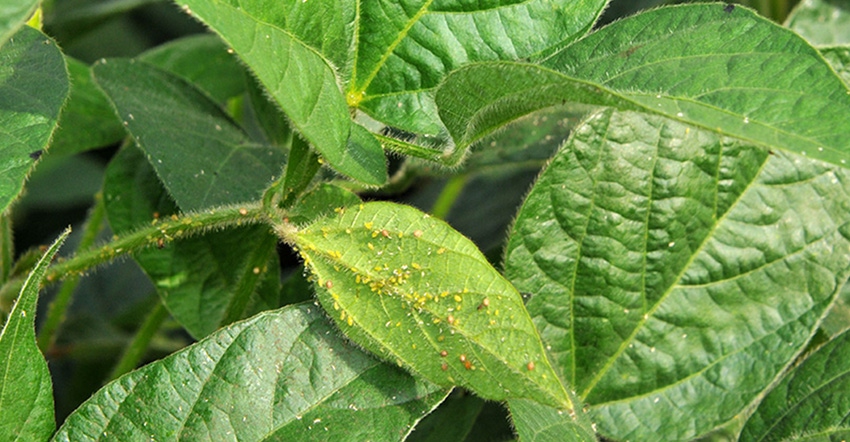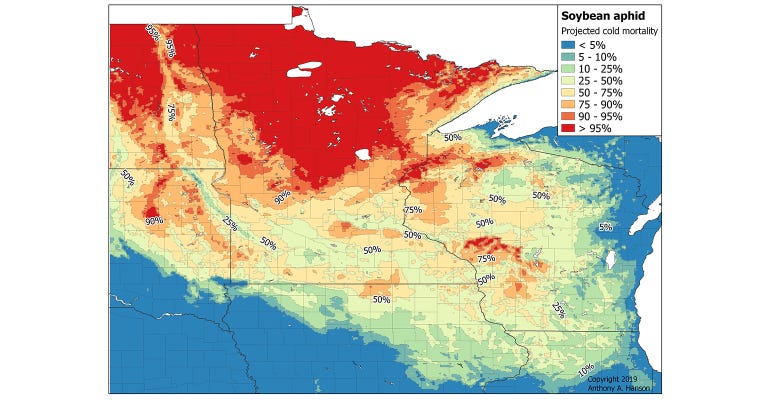
Subzero temperatures in January took a toll on soybean aphid eggs overwintering in buckthorn, according to University of Minnesota Extension entomologists. Yet, farmers still need to be watching for the pest throughout the growing season.
Anthony Hanson, U-M Extension post-doctoral associate and Robert Koch, Extension entomologist, looked at temperatures on Jan. 31, which were near or below minus 30 degrees F that morning, and did some insect forecasting by estimating soybean egg mortality.
Similar to weather forecasting, insect forecasting can provide a general idea of future insect populations. The minimum winter temperature can help forecast freeze mortality where insects overwinter. Some insects, such as corn rootworm, overwinter in leaf litter or soil, where they are protected from temperature extremes, especially when there is heavy snow cover.
Most areas of Minnesota had between one to two feet of snow cover during the coldest parts of this winter.
Pests directly exposed to air temperature, such as soybean aphid, would be most affected by the cold snap, they said in a news release. Soybean aphids overwinter as eggs on buckthorn buds where there is little protection from the cold, unless they are under insulating snow cover. Eggs freeze between minus 25 and minus 35 degrees — temperatures that were widely seen across Minnesota on Jan. 31. Some egg mortality can also occur above freezing, due to dehydration and late-fall cold snaps, they said.
Based on the weather data, the entomologists said the late January cold snap won't eliminate soybean aphid from Minnesota, but it could reduce early-season populations in some areas.
“Winter mortality is only one piece of the puzzle when forecasting if an insect pest will be a problem,” Hansen said. “We wanted to show that mortality was pretty high this year, but it's no guarantee soybean aphid won't be a problem in the upcoming year. We can only say it likely helped slow down soybean aphid. Economically-damaging population levels can still occur even then due to aphids blowing up from southern states or what remnants there are that did manage to overwinter. Scouting is still needed to see if that risk is still too high.”
In 2018, most of the soybean aphid problems were in the southern half of Minnesota, Koch added. The southern part of the state experienced some very cold temperatures this winter, plus that part of the state had little snow as potential insulation for the first half of the winter.
In contrast, northern Minnesota had few aphids in 2018, but more snow over the winter, he said
 THE LOWS: These were the morning lows on Jan. 31, 2019, provided by the U.S. National Phenology Network. University of Minnesota entomologists used this data when doing their soybean aphid forecasting.
THE LOWS: These were the morning lows on Jan. 31, 2019, provided by the U.S. National Phenology Network. University of Minnesota entomologists used this data when doing their soybean aphid forecasting.

Both entomologists encourage farmers to still scout fields early so they can stay on top of soybean aphid populations.
Scouting and management
Early in the season, pay particular attention to fields in areas with abundant buckthorn, smaller fields with wooded borders and early-planted fields. At this time of year, soybean aphids will typically be found on the new growth. The presence of lady beetles or ants on soybean plants is often an indicator of the presence of early-season aphid colonies.
 APHID FORECASTING: University of Minnesota entomologists show what they predict as soybean aphid cost-exposure mortality that occurred on Jan. 31, 2019 based on the average freezing point of overwintering eggs at -29 degrees F and minimum air temperature. Above are morning lows that day provided by the U.S. National Phenology Network.
APHID FORECASTING: University of Minnesota entomologists show what they predict as soybean aphid cost-exposure mortality that occurred on Jan. 31, 2019 based on the average freezing point of overwintering eggs at -29 degrees F and minimum air temperature. Above are morning lows that day provided by the U.S. National Phenology Network.

Later in the season, aphids are more commonly found throughout the canopy of the plant.
Go online for more information on scouting for soybean aphids.
About the Author(s)
You May Also Like






